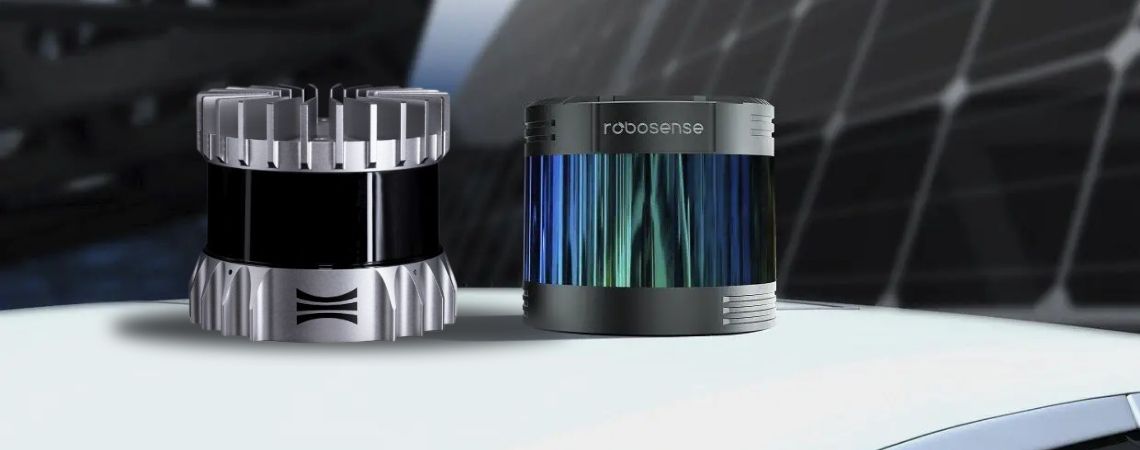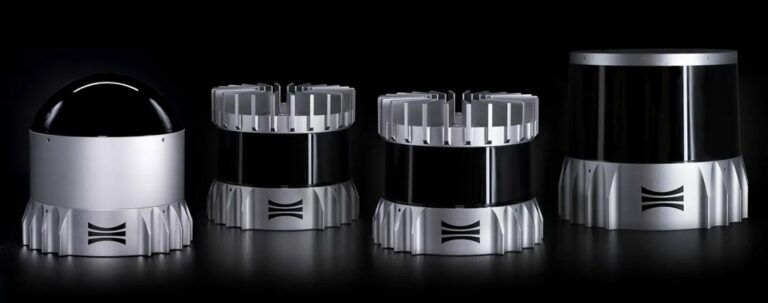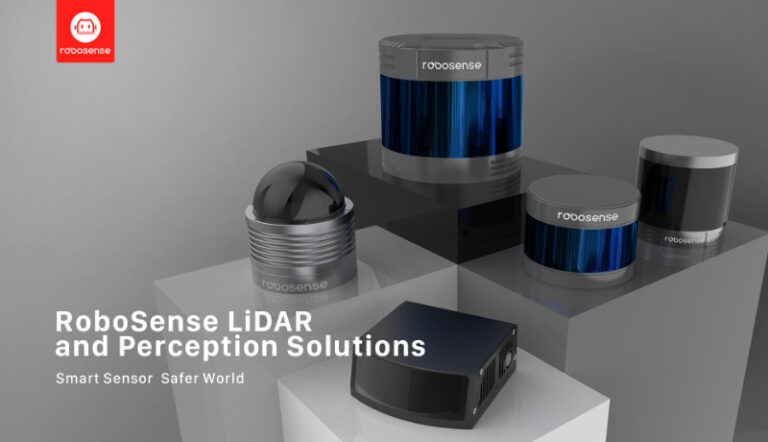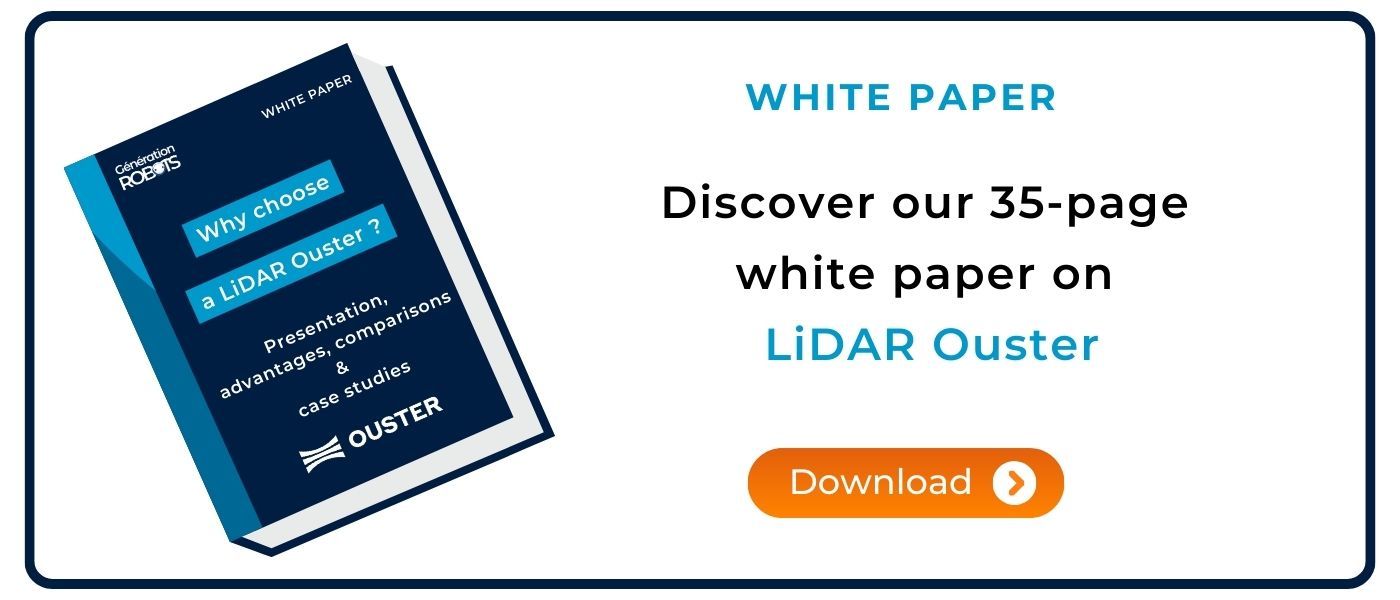LiDARs (Light Detection and Ranging) are optical sensors used to measure the distance and location of any object in its environment. Ouster LiDARs and RoboSense LiDARs are among the most advanced on the market. These high-resolution 3D sensors are mainly used for autonomous applications such as robotics, autonomous driving and mapping. Are you wondering which LiDAR would be the more suitable for your projects? The following blogpost is a detailed comparison about the 2 brands to help you choose the most appropriate LiDAR for your application.
Ouster: accuracy and reliability on a large scale
Ouster is an American company that builds high-resolution LiDARs for industrial, automotive and robotics applications.
Compact, modular and extremely durable, Ouster LiDARs are known for their high resolution and long range, making them ideal for mapping and localization.
Ouster LiDARs have a resolution of up to 128 channels, which enables them to detect small objects with a great accuracy. They are also designed to operate in harsh environments, such as rain, snow and fog.
RoboSense: advanced solutions for sensing the surroundings
RoboSense is a Chinese company that manufactures LiDARs for autonomous vehicles.
RoboSense LiDARs are known for their long range (150m, 200m) and high accuracy.
ROS compatible, they use MEMS technology to achieve high resolution, which makes them ideal for road safety applications.
RoboSense LiDARs also have a compact and light design, which makes them easy to integrate into autonomous vehicles or mobile robots: commercial vehicles, mobile robots operating in warehouses, robotaxis, self-driving buses, but also surveillance or explorationrobots.
Ouster vs Robosense: Comparison of the different models
1) Helios-32 VS OS1-32 (REV 6)
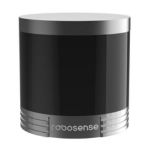
Helios-32 |
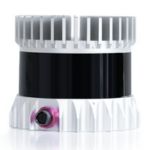
OS1-32 REV6 |
|
| Number of laser beams | 32 | 32 |
| Laser wavelength | 905 nm | 865 nm |
| Range | 150 meters | 120 meters |
| Vertical field of view | 70° (-55° à +15°) | 45° (-22.5º à +22.5°) |
| Vertical angular resolution | Up to 1,33° | 0.7° |
| Horizontal angular resolution | 360° | 360° |
| Accuracy | ± 2 – 3 cm | ± 0.7 – 5 cm |
| Points per second | 576 000 pts/s (Single Return Mode)
1 152 000 pts/s (Double Return Mode) |
Up to 2 621 440 pts/s |
| Rotational frequency | 10 or 20 Hz | 10 or 20 Hz |
| Power consumption | 12 W | 14 – 20 W |
| Weight | 1000 g | 447 g |
| Protection rating | IP67 | IP68, IP69K |
| Operating temperature | -30° to +60 °C | -40 °C to +60 °C |
| Price | 4560,00 € incl. VAT | 5657,15 € incl. VAT |
What we think:
The Helios-32 offers a better range as well as a wider field of view, which enables it to keep a detailed assessment of the road and its obstacles. More compact and lighter, the OS1-32 is easy to mount on all systems and has a high level of protection against dust and humidity. In addition, it provides more points per second, which allows a more accurate representation of its environment. Price-wise, the OS1-32 is more expensive.
2) Ruby Lite vs OS1-64 (REV 7)
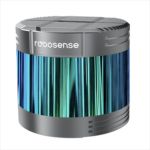
Ruby Lite |
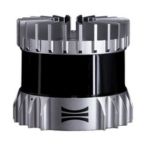
OS1-64 REV7 |
|
| Number of laser beams | 80 | 64 |
| Laser wavelength | 905 nm | 865 nm |
| Range | 230 meters | 200 meters |
| Vertical field of view | 40° | 45° (-22.5º à +22.5°) |
| Horizontal field of view | 360° | 360° |
| Vertical angular resolution | Up to 0,1° | 0.7° |
| Horizontal angular resolution | 0,1°/0,2°/0,4° | Up to 0,18° |
| Accuracy | ± 3 cm | ± 0.5 cm àto± 5 cm |
| Points per second | 1 440 000 pts/s (Single Return Mode)
2 880 000 pts/s (Double Return Mode) |
Up to 5 242 880 pts/s |
| Rotational frequency | 5, 10 or 20 Hz | 10 or 20 Hz |
| Power consumption | 38 W | 14 – 20 W |
| Weight | 3750 g | 447 g |
| Protection rating | IP67 | IP68, IP69K |
| Operating temperature | -30° to +60 °C | -40 °C to +70 °C |
| Price | 21 600,00 € incl. VAT | 17 520,00 € incl. VAT |
What we think:
More affordable than its predecessor RS-Ruby, the RS-Ruby Lite has a greater range and number of beams than the OS1-64 (REV 7). More expensive than the latter, it is intended for research laboratories and industries. The OS1-64 stands out once again for its reliability thanks to its compliance with IP68 and IP69K standards and also for its ultra compact size (447 g vs. 3750 g). In addition, it provides more point clouds highlighting physical details invisible to other LiDARs.
3) Ruby vs OS1-128 (REV 7)
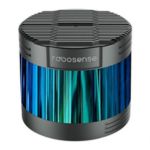
Ruby |

OS1-128 REV7 |
|
| Number of laser beams | 128 | 128 |
| Laser wavelength | 905 nm | 865 nm |
| Range | 250 meters | 200 meters |
| Vertical field of view | 40° | 45° (-22.5º to +22.5°) |
| Horizontal field of view | 360° | 360° |
| Vertical angular resolution | Up to 0,1° | 0.7° |
| Horizontal angular resolution | 0,2°/0,4° | Up to 0.18° |
| Accuracy | ± 3 cm | ± 0.5 cm à ± 5 cm |
| Points per second | 2 304 000 pts/s (Single Return Mode)
4 608 000 pts/s (Double Return Mode) |
Up to 5 242 880 pts/s |
| Rotational frequency | 10 or 20 Hz | 10 or 20 Hz |
| Power consumption | 45 W | 14 – 20 W |
| Weight | 3750 g | 447 g |
| Protection rating | IP67 | IP68, IP69K |
| Operating temperature | -30° to +60 °C | -40 °C to +70 °C |
| Price | 30 000€ incl. VAT | 18 840,00€ incl. VAT |
What we think:
RS-Ruby, RoboSense’s most advanced model so far, wins hands down when it comes to range (up to 250 meters). Although there is still a blind spot of about 40 cm, the very high accuracy and resolution of this 128-beam rangefinder make it a state-of-the-art piece of equipment. However, it is much more expensive than Ouster”s OS1-128 which has some very interesting features: up to 5.2 million dots per second, high protection rating and ultra compact size.
Conclusion
Both brands offer high quality products at relatively high costs. The choice of the brand of 3D LiDAR will depend on the specific needs of your application’s brief. Users will need to carefully evaluate the features of each product and compare them with their application requirements to make an educated purchase decision.
However, in our opinion, Ouster stands out from RoboSense in several aspects:
- Fast delivery in only 2 weeks (stock in Europe)
- An L3 chip that provides up to 5.2 million points per second allowing for more accurate representation of surfaces and features.
- Ouster LiDARs are much lighter and more compact than RoboSense LiDARs.
- Finally, and most importantly in our opinion, the OS REV7 LiDARs have a built-in infrared camera that allows video rendering of the environment:


